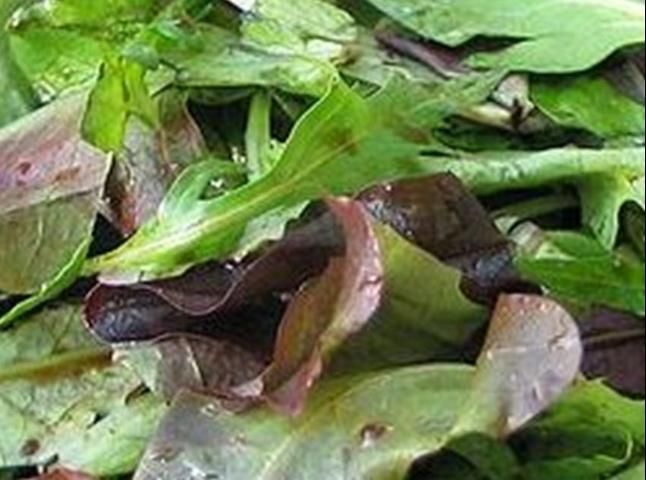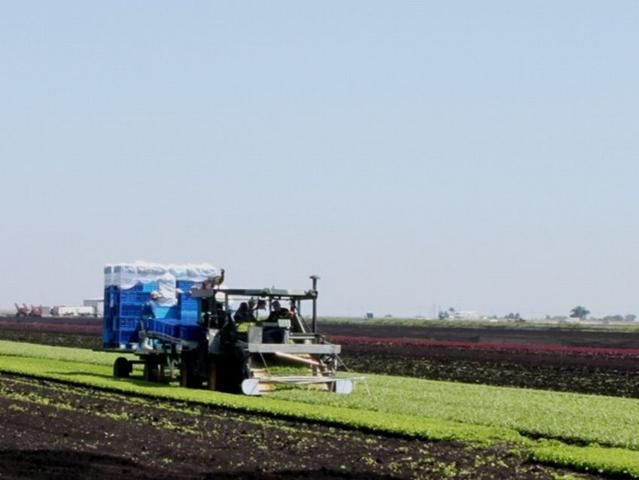Spring mix is a relatively new type of salad mix produced in the Everglades Agricultural Area (EAA) of South Florida. These spring mixes consist of a blend of different types of baby leafy vegetables, harvested young for tenderness, and that come ready-cut and washed in packaged containers. This document describes the components of spring mix, explains the reasons why consumers are looking for these mixes, and why growers in Florida are producing them.
Components of Spring Mix
Spring mix is comprised of a diverse and variable mixture of freshly cut baby leafy vegetables, including baby lettuces, endive, radicchio, arugula, spinach, and other baby greens (Figure 1). They vary in color, shape, texture, flavor, nutritional content, and smell. The leaves are freshly harvested at a young and tender stage, which gives spring mix a finer and gentler feel compared to traditional salads. The baby leaves remain intact and are wavy or oval—with deep splits—and are splendid in color, which gives them a natural and holistic sense of visual and taste appeal. All of these features combine to create a healthy product, low in calories and cholesterol, and with a more interesting flavor and texture than traditional salads.

Traditionally, iceberg (head) and romaine lettuce comprised the leafy greens component of salads (Figure 2). In recent years, inclusion of baby leafy greens in the market has been shown to increase nutritional levels of salads. The baby greens contain higher amounts of B vitamins and other minerals than head and romaine lettuce. Baby greens also have stronger tastes, which is a reason why they are generally not consumed on their own but rather part of spring mix. The leafy greens also add to the fiber level, making spring mix beneficial for the health of consumers.

Consumer Demand
Healthy eating is a strong trend in the US that generates a sizable new market for healthy foods going green. New products try to follow the tendencies the market dictates, and spring mix is no exception. Consumers are looking for products that are beneficial to their health, taste good, and are easy to prepare and consume. From this point of view, ready-to-serve spring mix is a very appreciated product. They reduce the time required for preparation, and there is no cutting or washing needed, so spring mix is convenient for consumers.
Spring Mix Production
Spring mix presents new benefits and challenges for growers of leafy greens in the EAA, where most of the commercial production is centered. Since spring mix demand is increasing, growers are able to diversify their operations by shifting more of their acreage toward production of spring mix. But at the same time, growers need to adapt to new production practices, better identify changes in consumer demand, and develop new marketing channels for this crop.
Production of baby leaf vegetables requires a high amount of labor in a short period of time. The time interval from planting (Figure 3) to harvesting (Figure 4) is only about one month. And because of the seasonal nature of these crops, suitable weather for their production is primarily from September until April. The summer months are too wet and hot for optimal growth of baby greens.


Spring mix is planted in wide, raised beds (Figure 3) with 20–25 rows per bed. All of the ingredients from spring mix are harvested young, and harvesting is accomplished mechanically before plant height reaches 5 inches (Figures 5 and 6). After harvesting, the leafy greens are quickly trucked to the packing house in bins where they are vacuum cooled, washed, spin-dried, mixed with other types of leafy greens, and packaged. Spring mix is often headed for the supermarket the same day as harvest.


Currently, production of spring mix represents a small portion of the approximately 10,000 acres of lettuce production within the EAA. However, acreage in spring mix greens is growing, and as markets grow and initial challenges are left behind, its production looks bright in the agricultural economy of the EAA.